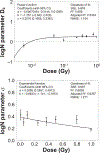Meta-analysis of Cognitive Performance by Novel Object Recognition after Proton and Heavy Ion Exposures
- PMID: 31415222
- PMCID: PMC6956595
- DOI: 10.1667/RR15419.1
Meta-analysis of Cognitive Performance by Novel Object Recognition after Proton and Heavy Ion Exposures
Abstract
Experimental studies of cognitive detriments in mice and rats after proton and heavy ion exposures have been performed by several laboratories to investigate possible risks to astronauts exposed to cosmic rays in space travel and patients treated for brain cancers with proton and carbon beams in Hadron therapy. However, distinct radiation types and doses, cognitive tests and rodent models have been used by different laboratories, while few studies have considered detailed dose-response characterizations, including estimates of relative biological effectiveness (RBE). Here we report on the first quantitative meta-analysis of the dose response for proton and heavy ion rodent studies of the widely used novel object recognition (NOR) test, which estimates detriments in recognition or object memory. Our study reveals that linear or linear-quadratic dose-response models of relative risk (RR) do not provide accurate descriptions. However, good descriptions for doses up to 1 Gy are provided by exponentially increasing fluence or dose-response models observed with an LET dependence similar to a classical radiation quality response, which peaks near 100-120 keV/µm and declines at higher LET values. Exponential models provide accurate predictions of experimental results for NOR in mice after mixed-beam exposures of protons and 56Fe, and protons, 16O and 28Si. RBE estimates are limited by available X-ray or gamma-ray experiments to serve as a reference radiation. RBE estimates based on use of data from combined gamma-ray and high-energy protons of low-LET experiments suggest modest RBEs, with values <8 for most heavy ions, while higher values <20 are based on limited gamma-ray data. In addition, we consider a log-normal model for the variation of subject responses at defined dose levels. The log-normal model predicts a heavy ion dose threshold of approximately 0.01 Gy for NOR-related cognitive detriments.
Figures






Similar articles
-
Predictions of cognitive detriments from galactic cosmic ray exposures to astronauts on exploration missions.Life Sci Space Res (Amst). 2020 May;25:129-135. doi: 10.1016/j.lssr.2019.10.004. Epub 2019 Oct 16. Life Sci Space Res (Amst). 2020. PMID: 32414486
-
Risks of cognitive detriments after low dose heavy ion and proton exposures.Int J Radiat Biol. 2019 Jul;95(7):985-998. doi: 10.1080/09553002.2019.1623427. Epub 2019 Jun 10. Int J Radiat Biol. 2019. PMID: 31120359 Free PMC article. Review.
-
Radiobiology with heavy charged particles: a historical review.Phys Med. 1998 Jul;14 Suppl 1:1-19. Phys Med. 1998. PMID: 11542635
-
Enhanced RBE of Particle Radiation Depends on Beam Size in the Micrometer Range.Radiat Res. 2024 Feb 1;201(2):140-149. doi: 10.1667/RADE-23-00217.1. Radiat Res. 2024. PMID: 38214379
-
Modelling carcinogenesis after radiotherapy using Poisson statistics: implications for IMRT, protons and ions.J Radiol Prot. 2009 Jun;29(2A):A143-57. doi: 10.1088/0952-4746/29/2A/S10. Epub 2009 May 19. J Radiol Prot. 2009. PMID: 19454805 Review.
Cited by
-
Dose-Effects Models for Space Radiobiology: An Overview on Dose-Effect Relationships.Front Public Health. 2021 Nov 8;9:733337. doi: 10.3389/fpubh.2021.733337. eCollection 2021. Front Public Health. 2021. PMID: 34820349 Free PMC article. Review.
-
Neuropsychological considerations for long-duration deep spaceflight.Front Physiol. 2023 May 19;14:1146096. doi: 10.3389/fphys.2023.1146096. eCollection 2023. Front Physiol. 2023. PMID: 37275233 Free PMC article. Review.
-
Life-long brain compensatory responses to galactic cosmic radiation exposure.Sci Rep. 2021 Feb 22;11(1):4292. doi: 10.1038/s41598-021-83447-y. Sci Rep. 2021. PMID: 33619310 Free PMC article.
-
A competing risks machine learning study of neutron dose, fractionation, age, and sex effects on mortality in 21,000 mice.Sci Rep. 2024 Aug 2;14(1):17974. doi: 10.1038/s41598-024-68717-9. Sci Rep. 2024. PMID: 39095647 Free PMC article.
-
Nano-scale simulation of neuronal damage by galactic cosmic rays.Phys Med Biol. 2022 Nov 25;67(23):10.1088/1361-6560/ac95f4. doi: 10.1088/1361-6560/ac95f4. Phys Med Biol. 2022. PMID: 36172820 Free PMC article.
References
-
- Information needed to make radiation protection recommendations for space missions beyond low-earth orbit. NCRP Report No. 153. Bethesda, MD: National Council on Radiation Protection and Measurements; 2006.
-
- Shulz-Ertner D, Tsujii H. Particle radiation therapy using proton and heavier ion beams. J Clinic Oncol 2007; 25:953–64. - PubMed
-
- Cucinotta FA, Manuel F, Jones J, Izsard G, Murray J, Djojonegoro B, et al. Space radiation and cataracts in astronauts. Radiat Res 2001; 156:460–6. - PubMed
-
- Chylack LT, Peterson LE, Feiveson A, Wear M, Manuel FK, Tung W, et al. NASCA report 1: cross-sectional study of relationship of exposure to space radiation and risk of lens opacity. Radiat Res 172; 2009:10–20. - PubMed
Publication types
MeSH terms
Substances
Grants and funding
LinkOut - more resources
Full Text Sources

